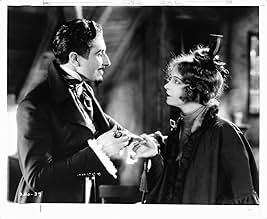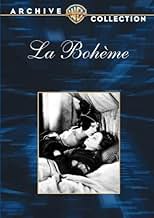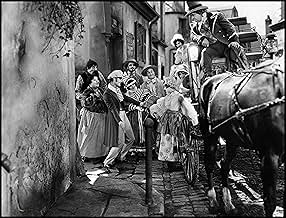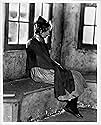NOTE IMDb
7,2/10
1,7 k
MA NOTE
Un groupe d'artistes affamés tente de survivre dans le Paris des années 1830, notamment une couturière et le futur dramaturge qu'elle aime.Un groupe d'artistes affamés tente de survivre dans le Paris des années 1830, notamment une couturière et le futur dramaturge qu'elle aime.Un groupe d'artistes affamés tente de survivre dans le Paris des années 1830, notamment une couturière et le futur dramaturge qu'elle aime.
- Réalisation
- Scénario
- Casting principal
- Récompenses
- 2 victoires au total
Mathilde Comont
- Madame Benoit
- (as Matilde Comont)
Eugene Pouyet
- Bernard
- (as Gene Pouyet)
Agostino Borgato
- Editor
- (non crédité)
Harry Crocker
- Bit Part
- (non crédité)
Blanche Payson
- Factory Supervisor
- (non crédité)
Avis à la une
Rodolphe (John Gilbert) is a wouldbe playwright struggling for that final bit of inspiration that will lead him to greatness. Mimi (Lillian Gish) is his upstairs neighbor, a seamstress and embroidery expert who works herself to the breaking point. Along with various painters, musicians and other poets, they all struggle to make ends meet until they finally have the success they all crave
The most famous bit of this one is the very ending, but I won't risk spoiling things, only to say that it's milked for all that it's worth. Gilbert looks even more like John Barrymore here, with his tousled hair and piercing eyes. Gish is her usual waifish, saintly self, although she was reportedly anything but offscreen during the making of this, her personal "love letter" to her European fans. I thought the film to be merely decent, with nothing beyond the ending to really recommend it.
The most famous bit of this one is the very ending, but I won't risk spoiling things, only to say that it's milked for all that it's worth. Gilbert looks even more like John Barrymore here, with his tousled hair and piercing eyes. Gish is her usual waifish, saintly self, although she was reportedly anything but offscreen during the making of this, her personal "love letter" to her European fans. I thought the film to be merely decent, with nothing beyond the ending to really recommend it.
It's difficult to imagine what going to the movies was like during the Silent Era. With no soundtracks, and a person in the theater simply accompanying the on-screen action on piano, dramas of the day must have suffered somewhat. But not 'La Boheme'.
As this wonderfully engaging tale of struggling actors and writers in France unfolds, it has a quality to its story telling that would have diminished had it been a talkie. Once you see the frail and beautiful (and quite haunting) Lillian Gish in her key scenes, you will never forget her.
Grab a few hankies and enjoy this singular silent screen treat!
As this wonderfully engaging tale of struggling actors and writers in France unfolds, it has a quality to its story telling that would have diminished had it been a talkie. Once you see the frail and beautiful (and quite haunting) Lillian Gish in her key scenes, you will never forget her.
Grab a few hankies and enjoy this singular silent screen treat!
NO, this silent Gish/Gilbert version of "La Boheme" is NOT BASED on the Puccini opera. Gish and the studio could not obtain the rights to the Puccini material. It IS based on Henry Murgi's 1851 novel "Life in the Latin Quarter." And once again IMDb insists I must pad out my comment to meet their silly minimum guidelines.
I do agree with other posters than you cannot view silent and sound films in the same way. No matter how great the performers involved, the 'mime' aspects seem very unnatural to modern eyes. You have to set aside prejudices on technique, especially if you are unused to viewing silent films, which can often seem melodrama and corny. I do enjoy watching Gish though.
I do agree with other posters than you cannot view silent and sound films in the same way. No matter how great the performers involved, the 'mime' aspects seem very unnatural to modern eyes. You have to set aside prejudices on technique, especially if you are unused to viewing silent films, which can often seem melodrama and corny. I do enjoy watching Gish though.
Stories like this have a certain kind of timelessness and familiarity to them, because they are based around characters and situations which recur again and again in art and literature. And in the case of La Boheme, it is a central concept which has particular resonance for the passionately creative amongst us. For here we meet the romantic archetype of the artists who will die for their art – writers, painters and musicians, lovers and libertines all, starving in the garrets of 19th century Paris. The story comes from the 1896 Puccini opera, but elements of it crop up as recently as the 2001 movie Moulin Rouge! During this era, there wasn't really anyone better suited to playing the female lead than Lillian Gish, and perhaps there never has been. Tender, mysterious, as light and ethereal as a strip of gauze, she was in every way the tragic heroine. At her best when she played it subtle, her performance in La Boheme is wonderfully subdued. So much lies in the tiniest flicker of her face, such as that little curl of her lip when she gets her first glimpse of John Gilbert. Gilbert is not nearly as fine an actor as his leading lady, but he is again very much the right type for his part – an idealist with intelligent eyes and a warm smile. Other faces to look out for here are the very entertaining French actress Renée Adorée, and a rare glimpse of a silent-era Edward Everett Horton, although sadly before his comic talent was fully realised.
The director is King Vidor, himself a man with a burningly artistic approach to his medium, albeit one grounded enough in reality and focused enough in thought to make him a good professional. His shot composition shows a neat use of space, and confident handling of rhythm. But what really makes Vidor stand out is the smooth way he makes shots that little bit special. Take for example the scene in which Vicomte Paul first lays eyes on Gish. We get a travelling point-of-view shot as he watches one young woman walking alongside his carriage. The carriage then stops, the woman carries on walking to reveal Gish heading straight towards the camera. We then cut in to a close-up of her face. The moment jolts itself into our consciousness, and because the movement of the camera and the two women is logical, it draws us further into the film's world, rather than exposing the artifice of the medium. King Vidor was one of the best directors who ever lived, because he successfully bridged the gap between the stylish and the realistic.
The resultant picture is a good work of classic romantic tragedy, and ultimately one that relates more to fantasy and mythology than to any real world situation. Poverty and injustice play their parts in La Boheme, but they are presented in almost noble terms, like some depiction of suffering in a religious painting. Compare this to poverty-themed pictures made just a few years later during the depression, which were earthy, honest and very close to home. La Boheme on the other hand is more the agonising, bittersweet fairytale. And there is no shame in this – it is simply a part of the idealism of the 1920s and of silent cinema, a naïve but beautiful way of thinking that was very soon to vanish with the changing times.
The director is King Vidor, himself a man with a burningly artistic approach to his medium, albeit one grounded enough in reality and focused enough in thought to make him a good professional. His shot composition shows a neat use of space, and confident handling of rhythm. But what really makes Vidor stand out is the smooth way he makes shots that little bit special. Take for example the scene in which Vicomte Paul first lays eyes on Gish. We get a travelling point-of-view shot as he watches one young woman walking alongside his carriage. The carriage then stops, the woman carries on walking to reveal Gish heading straight towards the camera. We then cut in to a close-up of her face. The moment jolts itself into our consciousness, and because the movement of the camera and the two women is logical, it draws us further into the film's world, rather than exposing the artifice of the medium. King Vidor was one of the best directors who ever lived, because he successfully bridged the gap between the stylish and the realistic.
The resultant picture is a good work of classic romantic tragedy, and ultimately one that relates more to fantasy and mythology than to any real world situation. Poverty and injustice play their parts in La Boheme, but they are presented in almost noble terms, like some depiction of suffering in a religious painting. Compare this to poverty-themed pictures made just a few years later during the depression, which were earthy, honest and very close to home. La Boheme on the other hand is more the agonising, bittersweet fairytale. And there is no shame in this – it is simply a part of the idealism of the 1920s and of silent cinema, a naïve but beautiful way of thinking that was very soon to vanish with the changing times.
La Boheme is a notoriously unreleased film that sometimes broadcasts on TCM. Thanks to a great cast featuring Lillian Gish, John Gilbert, and Renee Adoree, it is no wonder why fans clamor to see it. The star power indeed makes the film a good one. The story is one of sadness and heartbreak; two people live struggling to make ends meet in a shabby town in France. He is working as a writer, succumbing to pieces for the newspaper for money while he can flesh out his play. She is a seamstress whose love for him leads her to working herself to death. The love story is tragic and beautiful.
I have never understood the appeal of Gilbert, so I was not as interested in his character or, in consequence, the romantic relationship between he and Gish than I could have been. He is not a bad actor; I simply do not gravitate to his type. Gish is wonderful, however, as a pathetic but beautiful woman. One bright spot of this film was the couple's scenes on a picnic running through the wilderness in the sunlight.
I have never understood the appeal of Gilbert, so I was not as interested in his character or, in consequence, the romantic relationship between he and Gish than I could have been. He is not a bad actor; I simply do not gravitate to his type. Gish is wonderful, however, as a pathetic but beautiful woman. One bright spot of this film was the couple's scenes on a picnic running through the wilderness in the sunlight.
Le saviez-vous
- AnecdotesJohn Gilbert was infatuated with Lillian Gish and would mess up his "love scenes" with her on purpose, so he could keep kissing her.
- GaffesThe opening shot of Paris shows Notre Dame Cathedral with its famous spire. At the time the film is set, the 1830s, the spire did not exist. The original was demolished in the early 1790s and not rebuilt until 1860.
- Citations
Title Card: Paris - Mother of the Arts...
- ConnexionsFeatured in American Masters: Lillian Gish: The Actor's Life for Me (1988)
Meilleurs choix
Connectez-vous pour évaluer et suivre la liste de favoris afin de recevoir des recommandations personnalisées
Détails
- Date de sortie
- Pays d’origine
- Langue
- Aussi connu sous le nom de
- La Boheme
- Lieux de tournage
- Arcadia, Californie, États-Unis(elaborate picnic in the woods of Ville-d'Avray)
- Société de production
- Voir plus de crédits d'entreprise sur IMDbPro
Box-office
- Budget
- 693 000 $US (estimé)
- Durée
- 1h 35min(95 min)
- Mixage
- Rapport de forme
- 1.33 : 1
Contribuer à cette page
Suggérer une modification ou ajouter du contenu manquant

































